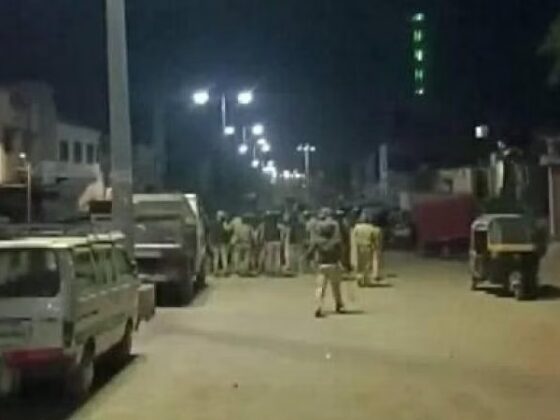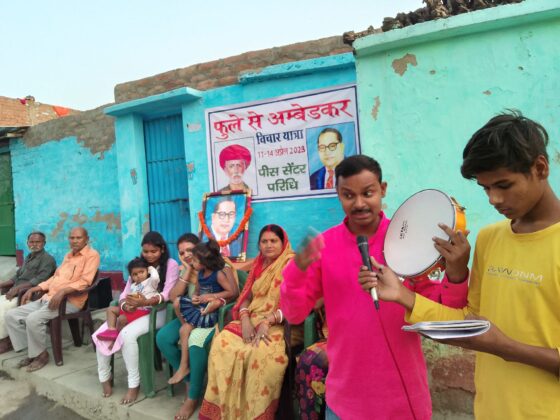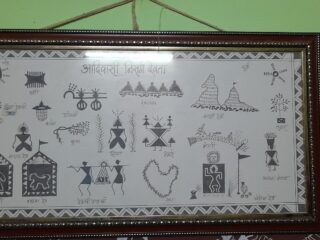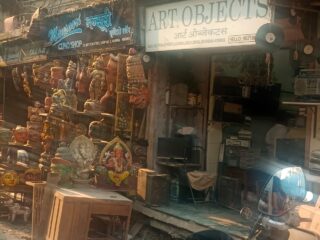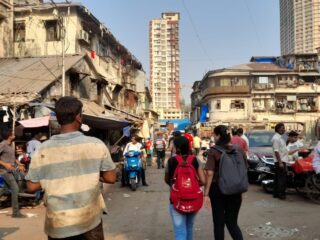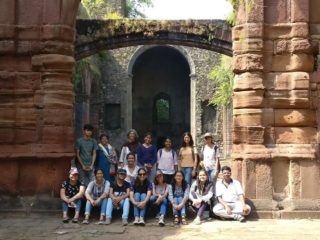Neha Dabhade
“Mazgaon is truly cosmopolitan, not only are there diverse communities here but also that they have accepted one another and live beautifully together”, said Rafique Baghdadi, celebrated historian who has been organizing heritage walks of Mazgaon for many years. The Mazgaon heritage walk was organized by Centre for Study of Society and Secularism as part of its ‘Diversity in Mumbai’ Course, conducted currently with students of Diploma of Social work from Nirmala Niketan. A long-time resident of Mazgaon, he really captured the essence of Mazgaon in so many words. Mazgaon has been home to different communities- Parsis, Jews, Christians, Hindus, Muslims and even the small Chinese community. What makes Mazgaon fascinating is the mix of communities and the culture and architecture that emerges out of it. The group of students walked astounding parts of Mazgaon they didn’t know existed. The walk took all of us down a lane of history where we witnessed the marvels of time right in front of our eyes in this charming locality marked by rich heritage.
History:
Mazgaon was one of the original seven islands which made up Bombay. The name Mazgaon can be traced to “maze- gaon” that is my village or ‘maccha’ gaon meaning fishing village. Naturally, the first inhabitants of Island were the fisherfolk and the salt makers. The coming of the British shaped the livelihoods, culture and the lives of the people in a big way.
The dockyard and the British ambitions for large scale trade meant that people from across the world but especially the Chinese were encouraged to come to work on the docks and ships. There were waves of migration and life was reorganized around the docks- the dockyard gave employment to many people. Many were enrolled in the British services. The British built infrastructure including housing for its personnel as well as those working on the docks. Social and cultural institutions also emerged to support this migration. One of the stark examples of this would be the Chinese temple in Mazgaon which was built for the Chinese community who came to work on the ships in Mazgaon.
Similarly, Mazgaon was also known for its agricultural products. For instance, Ambewadi where mangoes were grown in Mazgaon was famous. In fact, it is believed that the mangoes grown in Ambewadi were so tasty that they were sent to Emperor Aurangzeb. Additionally, jackfruits were also grown in Mazgaon. Over the years, Mazgaon has attracted and offered abode to multiple communities and is dotted with iconic heritage grade architecture and some beautiful places of worship including the Chinese temple, the Hasanabad- Taj Mahal lookalike and the resting place of Aga Khan I, the 46th Imam of the Nizari or Ismaili Muslims, Magen David Synagogue. Interestingly, Mazgaon is also home to many crosses- reminder of the faith of the residents who constructed them to keep away the deadly bubonic plague hundreds of years back. There are also Jew cemeteries and different Shia and Sunni Kabrastans. One of them is the home to the grave of late iconic actress Meena Kumari which is also a huge attraction in Mazgaon.
Diversity within Communities:
The one aspect of Mazgaon that really struck the students was that it is home to sizeable population of Christians. But what was unknown to them was the rich diversity within the Christian community that is reflected in Mazgaon. While the group was aware of the Roman Catholic community, they were fascinated to learn about the East Indian Christian community. In Matharpacady village, which we will discuss in details later, the east Indian community own most of the houses. The students asked some of the residents about their culture and community. They discovered that this community is one of the oldest and most established Christian communities in Mumbai, with a history that dates back to the 16th century.
The East Indian Christian community in Mazgaon is known for their unique culture and traditions, which are a blend of Indian, Portuguese, and British influences. They are a close-knit community that values family and community, and their traditions are passed down from one generation to the next. One of the most distinctive aspects of the East Indian Christian community in Mazgaon is their cuisine. Their food is a delicious blend of Indian and Portuguese flavors, with dishes like sorpotel, vindaloo, and balchao being popular among the community. Many of these dishes are made with pork, which is a staple in the community’s diet. It is no wonder that while we were wandering in the alleys of Matharpacady, our minds were distracted with the aromatic draft of food being prepared for Sunday lunch in the houses!
Our Lady Of The Rosary Church
The East Indian Christian community in Mazgaon is also known for their vibrant music and dance traditions. They have their own unique style of music called “Mando,” which is a blend of Indian and Portuguese music. The community also has their own traditional dance called the “East Indian Folk Dance,” which is performed at weddings and other celebrations. The community in Mazgaon has several churches, including the St. Anne’s Church, St. Peter’s Church, and Our Lady of Glory Church. These churches are not only places of worship but also serve as important community centers, hosting events and celebrations throughout the year.
Lion’s den bungalow
What really served as a treat was the quaint village of Matharpacady. Declared as a heritage precinct, the village opposite the iconic Lion’s den bungalow is a mosaic of colours in small alleys. One feel transported to Goa and its charm is palpable. The Portuguese architecture and its influence on the 60 odd houses consisting of this village is distinct- with narrow winding lanes, small houses with tiled roofs, and beautiful churches. The St. Anne’s Church, built in 1881, is one of the most famous landmarks of the village. The church has a beautiful facade with Gothic arches and stained-glass windows. There is a ‘Mary’s lodge’ which is dates back to the 1800s. The village also has several temples and shrines, including the Ganesh Temple and the Hanuman Temple.
Matharpacady Village
The village is situated on a small hill overlooking the Arabian Sea and was established in the 1700s by the East India Company. The name “Matharpacady” is derived from the Marathi words “Mathar” meaning “a raised platform” and “Pacady” meaning “a landing place.” This is because the village was built on a hill that had a landing place for boats on the sea-facing side. The village was initially inhabited by Koli fishermen, who were the original inhabitants of Mumbai. Over time, it became a melting pot of different communities, including Portuguese, Goan, and Maharashtrian.
At Matharpacady Village
The village has several festivals and events throughout the year, including the Feast of St. Anne, which is celebrated in July every year. During the festival, the entire village is decorated with lights and colorful decorations, and a procession is taken out with the statue of St. Anne. Christmas is also celebrated with great enthusiasm with beautiful décor. The otherwise serene alleys come alive with festivities. Some of the students of the ‘Diversity in Mumbai’ course have been lucky to experience these festivities when this course takes place around Christmas.
After speaking to some residents of this historic village, we were told that there are impediments in maintaining the heritage precinct. One of the them is that since the village is assigned grade III heritage status, there are stringent rules about alteration and renovations where only certain materials can be used after prior permission. The original plan of the houses cant be altered either. The rules according to some residents are not very practical. Another reality facing the village is that some of the houses are decrepit given that its owners are dead or migrated to other countries, leading to a state of disrepair of the structures. Sociologically, the residents rued that the character of the village is changing given the in the recent times, the houses are being bought over by members of the Bohra community. The real estate industry the residents pointed out always has keeps a keen vigil on the village for opportunities.
Kudds- The interesting connection of Mazgaon with Goa:
One of the most interesting result in terms of architecture and culture that has emerged from the docks and ships in Mazgaon is the institution of kudds. Kudds are essentially community dormitories- style clubs where members of Christian community from Goa can come and stay at nominal rates. Mostly those who come to stay at the Kudds are Goan men- mostly youngsters who come to Mumbai in search of employment or passing Mumbai for work or ‘shippies’ who have to spend a few days in Mumbai. Each kudd is named after the Goan village it serves. At their peak, there were 450 kudds in the city, concentrated in Mazgaon, Dhobi Talao and Chira Bazaar. Only 160 survive, according to the Federation of Goan Club (Kudd).
Each guest is given one trunk to keep their belongings in the Kudd. There is a common kitchen where food can be cooked. There are daily prayers and everyone lives like one big community. The very small fees of the Kudd which is unbeatable in an expensive city like Mumbai is but a small inventive to come stay at the Kudds. The real incentive is the feeling of community and a home away from home. Members from all walks of life come and stay together here because the Kudd fulfils the need of community life. The kudd system is truly unique to Mazgaon and adds to its charm.
Chinese Temple or Kwan Kung temple:
Chinese temple
Mazgaon was home to a nice thriving Chinese community or See Yup Koon community, originally from the Canton in the southern China. They were encouraged by the East India Company to migrate to India. They settled in Mumbai as merchants, traders and sailors. After the Sino-India war in 1962 and subsequently deteriorating relations between the two countries, many of the city’s Chinese residents migrated back to China. However, a few families decided to stay on in their homes in what had come to be known as China Town. The group of students were most excited about visiting this Temple. Painted in red, the temple has two floors. On the ground floor, there is a shrine of Goddess of Mercy. While climbing upto to the first floor, there are footprints of ‘Laxmi’ used mostly in Hindu Maharashtrian households indicating the integration of cultures. On the topmost floor is the altar of Kwan Tai Kwon, the warrior god- all in magnificent red which is considered auspicious.
At the temple, we could speak to Mr. Albert Tham who is the care taker of the temple. He explained to us that the Chinese New Year is the biggest festival of the Chinese community in Mumbai. That’s the time, the temple sees most of its members. However, Mr. Tham rued that the younger generation which is mostly engaged in hospitality industry- restaurants, salons and spas etc, are not in touch with the Chinese traditions and the reasoning behind them. He told us that most of them are converting into other religions and marrying outside the community. We found it interesting that he was wearing a Rudraksha around his neck. But he has a fascinating explanation. He said that there are different ways to feel one with God. One should test God. See if you feel the connection. See if he answers you. I feel connected with Shiva. I am his devotee”. One of the students asked him how often does he visit China. He quipped, “Mumbai is my home now. I speak fluent Marathi and Hindi. I cant speak fluent Mandarin. So I feel restless when I go to China. I seldom visit but when I visit China to see my relatives, I yearn to come back”. It struck the students how the Chinese culture is dying also owing to lack of schools to preserve Mandarin language and script.
Parsi Agiary
Lastly what struck us was the walk down the gunpowder road and the Parsi Agiary which has a connection to the legendary Madame Cama. There are many properties owned by the Parsis and they are regal quaint properties hinting at the prosperous community’s contribution to the locality. This visit is truly significant. One of the students at the end of the visit, while devouring Bun Maska at one the cafes said, “this visit gave us an opportunity to understand how cosmopolitan Mumbai is. We didn’t even know such a place existed in Mumbai though we have lived in Mumbai for so many years!”








